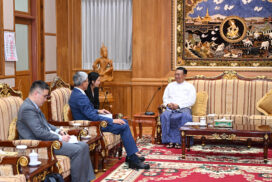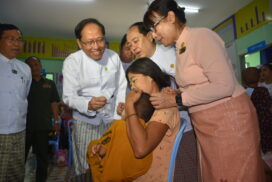By Maung Hlaing
Introduction
A look into history will reveal that during the time of Myanmar kings, the nation had the tradition of honouring outstanding literati, princes and court officials with titles. Such ceremonies made Myanmar literature flourish in accord with the conditions of those past ages and systems that then prevailed. Myanmar kings did so in order to honour the mass of writers who wrote literature for people’s sake. Generally, literati are honoured on the Sarsodaw Nay, or Literati Day as they have performed the task of developing and handing over literature to new generations by inheriting and preserving it.
The successive governments including the present government hold grand ceremonies to present literary awards to the outstanding winners on the 1st Waxing of Nadaw, the ninth month in the Myanmar calendar every year.
In modern times, we have seen the lofty aims of holding the ceremony since the time when the Burma Translation Society (BTS) was established on 26 August 1947. Among the 14-point aims and objectives, one of the objectives is “To institute or encourage research in Myanmar literature and the fine arts to bring about an improvement in mass education.” To implement the objective of the BTS, the literary award presentation ceremonies have been held since 1948.
The Early Days of Literary Awards
When the literary prizes were introduced, the then late Prime Minister U Nu once described the awards as an attempt to stimulate the production of ‘New Life Literature’ which should go hand in hand with the ‘New Life Culture’ that is building up Burma as an independent and sovereign country. [An excerpt from A report of the Burma Translation Society’s experience to date (February 1956), presented by the staff of the society.]
At the outset of the history of literary awards, ‘Sarpay Beikman Award (စာပေဗိမာန်ဆု) emerged between 1948 and 1961. Generally, it was known as the ‘Sarpay Beikman Contemporary Novel Award’ (စာပေဗိမာန်ကာလပေါ်ဝတ္ထုဆု) and Sarpay Beikman, formerly known as BTS, organized the ceremonies on behalf of the State. Each year from 1948 to 1957, a prize was awarded for the best Myanmar novel, the best translation of a great, or classic book, the best work of the belles lettres class, and the best work on any subject of general knowledge.
The first and foremost literary award went to the novel ‘Moe–out Myay–byin’ (မိုးအောက်မြေပြင်), or the Land under the Sky’ written by novelist Min Aung. The first prize-presenting ceremony was held in June 1949. The winner earned 1,000 kyats for his best work.
“Four important literary awards are made every year. One is for the best work of fiction (published during the calendar year) which must be an original work: neither translated nor adapted (prize: 1,000 Kyats)…
“Another is for a translation which must be of a novel and from English into Burmese. The original work must be a classic (prize: 750 kyats)…
“A third award is given for a work selected from historical biographies, autobiographies, travels, literary criticisms which are neither fiction, poetry nor drama (Pya-zat) (prize:1,000 Kyats)…
“The fourth award goes to any instructive, educative or informative work not included in the last category (prize:1,000 Kyats).”
Regarding the national literary awards, it was depicted vividly in the booklet entitled ‘SARPAY BEIKMAN, Palace of Literature, published in September 1958. From 1958 onwards, literary awards for other genres were added to the original four.
In 1962, the name of ‘Sarpay Beikman Award’, was changed to ‘Fine Art Literary Award’ (အနုညာစာပေဆိုင်ရာဆု). Up to 1962, all the prizes were presented for only the best work. However, the literary prize-giving system changed in 1963. From 1963 to 1969, four prizes—first, second, third and fourth—were set apart for each genre.
It was in the year 1965 that the name ‘Fine Art Literary Award’ was changed again to ‘National Literary Award’ (အမျိုးသားစာပေဆု). Which has been used up to date. Likewise, the system of giving first, second, third and fourth prizes for the literary award terminated in 1968. And presenting one prize for the best one for each genre resumed in 1969.
In the same year, the system of competition of both the works published and the manuscripts was completely abolished and all the literary works of the first edition in a calendar year were scrutinized by the ‘Selection Committee of the National Literary Awards’ (အမျိုးသားစာပေဆုစိစစ်ရွေးချယ်ရေးကော်မတီ). As a result, ‘Sarpay Beikman Manuscript Award’ (စာပေဗိမာန်စာမူဆု) emerged and all the manuscripts for competition were scrutinized by the separate ‘Selection Committee of Sarpay Beikman Manuscript Award’ (စာပေဗိမာန်စာမူဆု စိစစ် ရွေးချယ်ရေးအဖွဲ့). The writers who took part in the competition could pin their hopes on winning first, second and third prizes for each genre except the translation subject for which only the first prize was set apart. From that time onwards, the Sarpay Beikman Manuscript Award has been beneficial to old and new writers who cannot publish their manuscripts in book form for various reasons.
Sayagyi Paragu and National Lifetime Award for Literary Achievement
The ‘National Lifetime Award for Literary Achievement’ (အမျိုးသားစာပေ တစ်သက်တာဆု) was successfully introduced to the literary world with effect from 2022. The first and foremost recipient of the award was Sayagyi Paragu (Sithu U Hla Kyaing) who was selected (for 2001) in 2002. Since then the award has been presented to one writer or literary scholar whose literary works have contributed much to the nation and the people. Later, the number of recipients came to change in accordance with the decision of the selection committee.
The ‘National Lifetime Award for Literary Achievement’ is the highest literary award in Myanmar. To be objective, the emergence of the highest literary award was attributable to Sayagyi Paragu who was selected to be the recipient of the South East Asian Writers Award, officially known as S.E.A. WRITE AWARD offered by Thailand. Although he was selected, he failed to leave for Bangkok due to the immediate change of the government’s policy in those days. In brief, the literary award that would be the equal of the S.E.A. WRITE AWARD was given birth to the literary arena of Myanmar.
Saya Paragu was born of U Ba Saw and Daw May Toke in the village of Thanon Thanaut in Hinthada Township, Ayeyawady Region on 10 November in 1921. His name was Maung Hla Kyaing. He pursued his primary education in the primary school in Thanon Thanaut village. At the age of 11, his parents made him become a Buddhist novice. At 15, 16 and 17, Ko Hla Kyaing passed Pahtama-ngae, Pahtama-latt and Pahtama-gyi consecutively. When he was 19, he completed the Honours Course of Instructor-monk of Buddhist scriptures.
At 20 in 1941, he was ordained as a Buddhist monk at the Hinthada Myit-Kway Monastery. Then he continued to pursue education at the Hindi University in Varanasi, India between 1947 and 1952. Using the pen-name ‘Myo Nyunt Nwe’ U Hla Kyaing began to write in the ‘Toe Tet Yay Magazine of February 1939 issue. He took another pen name ‘Tha-ma-nay shin Paragu’ and wrote in the ‘Dagon Magazine’. The first literary work was a short story entitled ‘ရင်သွေး’ (The Progeny) that appeared in the ‘Toe Tet Yay’ magazine of August 1940 issue. He wrote that short story under the pen name ‘Phonegyi Kyaunthar’. In the same year, he passed the Dhamma Ceria Examination with distinction in three treatises.
During the Japanese occupation in 1942, he learned Japanese literature at the Japanese Language School in Thanlyin for two years and wrote an article in Japanese that appeared in a Japanese newspaper published at that time. He used his pen name ‘Shin Paragu’ for that article.
In 1947, he won a scholarship of Ariya Dhamma offered by an Indian rich man called Virala and as a result, he could join the Oriental Collage of Varanasi University in India to learn Hindi and Sanskrit. While he was studying at the university, he contributed several articles to the ‘Dhamma Duta Magazine’ published in Hindi by Migadawon Maha Bhodi Association. At the same time, he wrote articles for the ‘Journal Kyaw’ paper which was published in Yangon, Myanmar.
In 1952, he came back to Myanmar and translated ‘From Volga to Ganges’ (second part) by ‘Rahul Sanskrityayan’ under the pen name of ‘Weikza’. The first part of the book was translated by Sayagyi U Hsan Htun. In 1954, he took the nom de plume ‘Paragu’ and wrote the book “Words of Buddha” (ဗုဒ္ဓစကား) Then he left monkhood in 1954. As he possessed an established pen name, Saya Paragu attended the Asian Writers Conference held in New Delhi, India in 1956.
U Hla Kyaing worked as a translator at the Information Department of the Embassy of India in Myanmar. Similarly, he served as a member of the Committee of Oriental Studies for Universities and Colleges in Myanmar; a member of the Myanmar Language Committee, an executive member of the Centre of Myanmar Theravada Missionary; Patron of Theosophy Association, Vice-Chairman of the Myanmar Literature Propagation Association; Chairman of Tagore Association of Myanmar, Chairman of the Association of Hindi Literature; and took various duties in writers organization.
From 1939 onwards, U Hla Kyaing wrote over 150 books including translated works of his life, under the pen-names of ‘Myo Nyunt Nwe’ ‘Thanma-nay shin Paragu’ ‘Phongyi Kyaungthar’. Among them, ‘ဗုဒ္ဓစကား’ (Words of Buddha), ‘ဓမ္မစကား’ (Words of Dhamma), ‘ဗုဒ္ဓဒိုင်ယာရီ’ (Diary of Buddha), ‘နိဗ္ဗာန်’ (Nirvana), ‘သုန္ဒရနန္ဒ (ခေါ်) ညီတော်မင်းနန်’ (Thondra Nanda, or Younger Brother Min Nan) (That book won him Fine Art Literary Award on Translation genre for 1963), ‘သားတော်ရာဟုလာ’ (Son Rahula), ‘သိဒ္ဓတ္ထ’ (Siddhartha), ‘စိတ္တရလေခါ’ (Citra Lekha), ‘အမ္ဗပါလီ’ (Ambapali), ‘ပီယဒဿီ’ (Piya Datthi), ‘ပရကထာ’ (Pra Kahtar), ‘ဘဝခရီး သည်’ (Lifelong traveller), ‘ပုဂံခရီးသည်’ (Travellar of Bagan), ‘ဂေါရီ’ (the winning work of National Literary Award on translation genre for 1985) attracted the mass of readers. (Some titles are transliterated.)
Previously, he lived in Bahan Township. However, he moved to No.988-991, U Ponnya Street in Shwe Paukkan, North Okkalapa where he made his home to be a library and named ‘Paragu Shantiniketan Library’. It was opened to all with effect from 24 December 2005.
As he made efforts in the interest of the literary world of Myanmar, he won the National Lifetime Award for Literary Achievement in 2001, Lifetime Literary Award (of Pakokku U Ohn Pe’s literary funds) in 2002, Decoration of Outstanding in Arts (First Class) in 2003, Lifetime Literary Award offered by Thuta Swzone in 2005.
Sayagyi Paragu was the one who devoted all his life to the dissemination of literary knowledge among the younger generation. He really wanted young writers to be active and dynamic in carrying out literary activities.
About four decades ago when I began to join the Sarpay Beikman, I met him at the table of late Saya U Myo Thant (Maung Hsu Shin). The words he said to Maung Hsu Shin have still stuck in my mind.
“Ko Myo Thant…we need to give birth to young translators of a new generation. We’re now getting old. If you’re no longer here in Sarpay Beikman, there may be a shortage of promising translators.”
What he said was true.
Literature enriches the cultural life of the nation and influences social life in various ways. Sayagyi Paragu who did a lot for promoting national literary interest left all of his friends, books and the literary world he loved most, on 9 April 2011.
Reference :
အမျိုးသားစာပေတစ်သက်တာဆုရ စာပေပညာရှင်များ၏ စာပေနှင့် ဘဝအကြောင်းတစေ့တစောင်း (၂၀၀၁-၂၀၁၃)၊ စာပေဗိမာန်၊ ၂၀၂၁
Through the Window of Sarpay Beikman by Maung Swe Ngae, 2021
(Note:- The author of this article joined the Sarpay Beikman in 1980 and worked as Assistant Editor, Editor and Chief Editor. Although he retired in 2007, he is still working for Sarpay Beikman by participating in literary teams organized by the State.)















